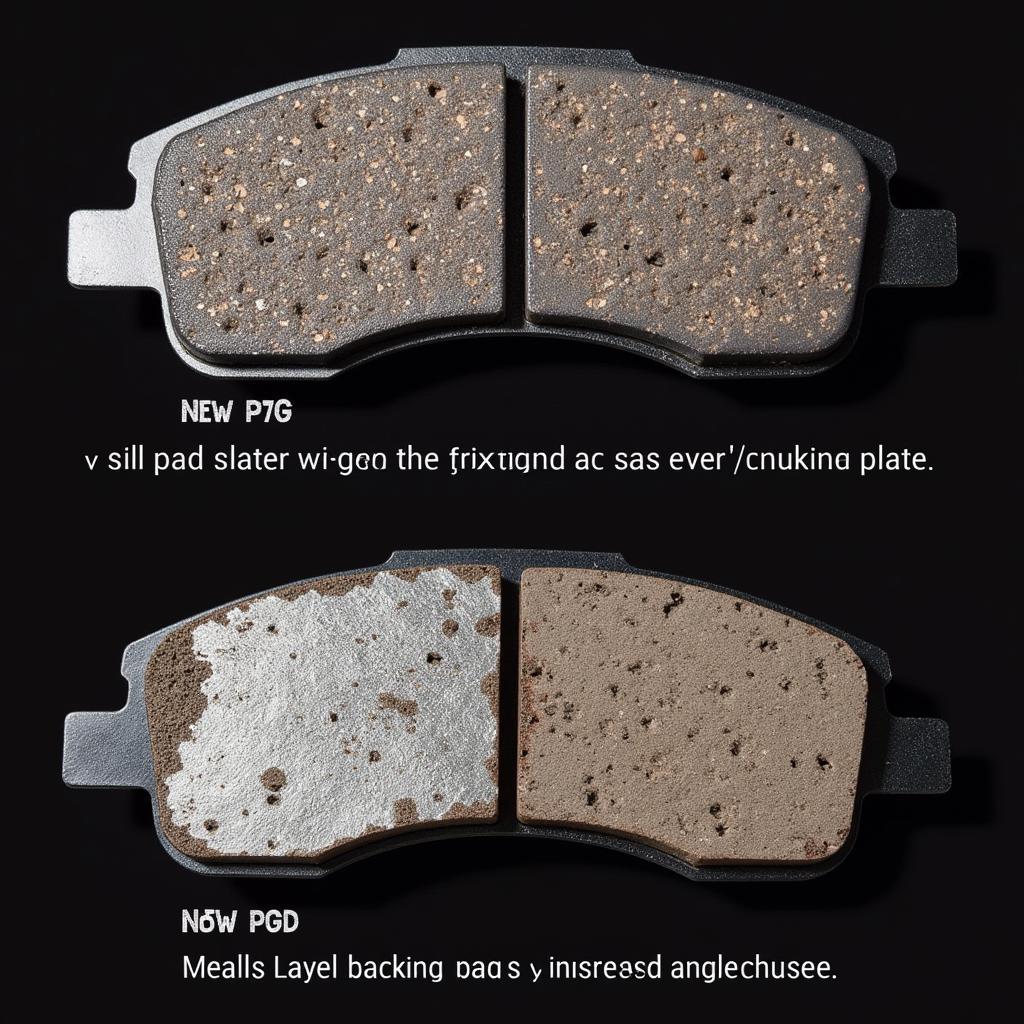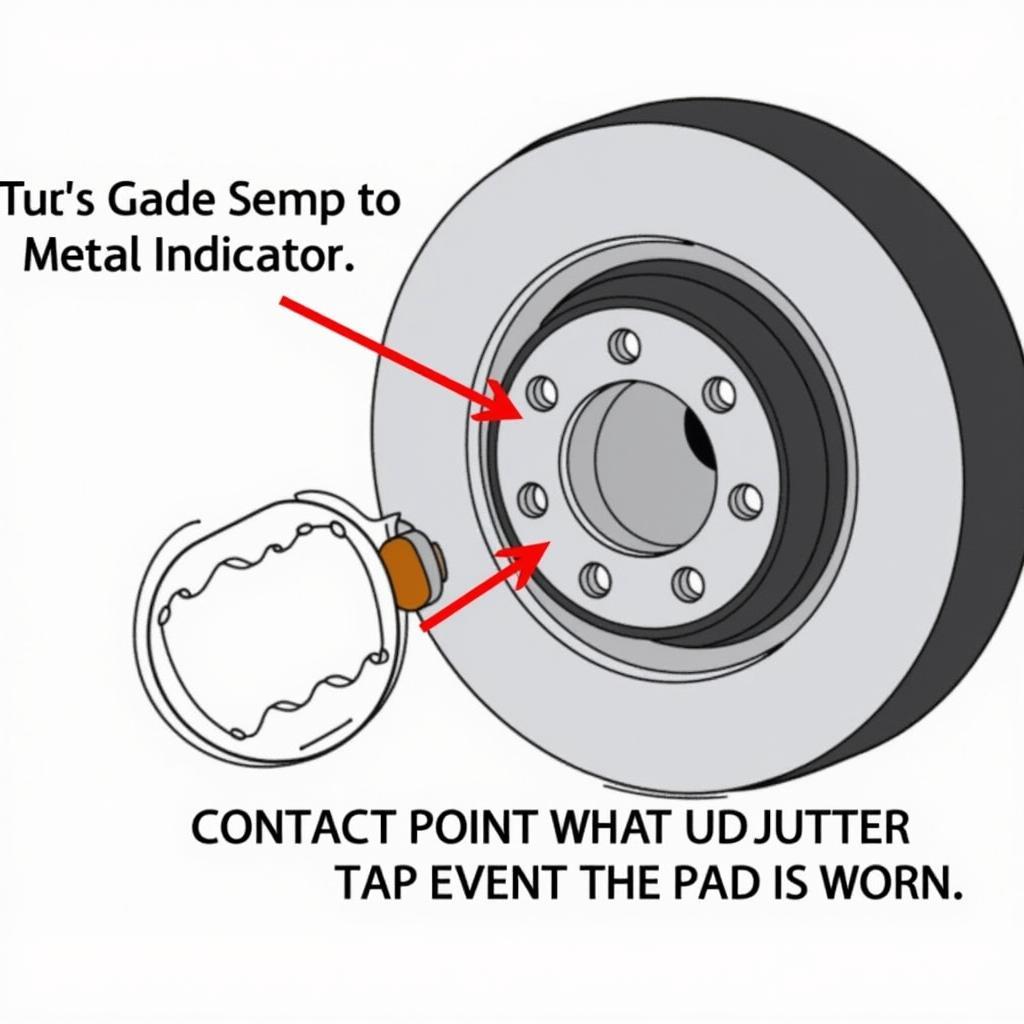A worn brake pads warning light illuminating on your dashboard means it’s time to pay attention to your car’s braking system. This light is a crucial safety feature, signaling that your brake pads have worn down to a point where they need immediate replacement. Ignoring this warning can lead to reduced braking efficiency and potentially dangerous driving conditions.
Understanding Your Car’s Braking System
Your car’s braking system relies on the friction between brake pads and rotors (or drums) to slow down or stop the vehicle. Brake pads are designed to wear down over time; they’re the sacrificial component protecting more expensive and critical parts like calipers and rotors.
 Worn Brake Pads
Worn Brake Pads
When you press the brake pedal, hydraulic pressure forces the calipers to clamp the pads against the rotors, creating friction that converts kinetic energy into heat, thus slowing or stopping your car. As you use your brakes, the friction material on the pads gradually wears away.
What Triggers the Worn Brake Pads Warning Light?
Most modern vehicles have a built-in wear indicator within the brake pad itself. This indicator is usually a small metal tab designed to contact the rotor and create a high-pitched squealing sound when the pad material wears thin. This audible cue is your first indication that your brake pads are nearing the end of their service life.
 Brake Pad Wear Indicator
Brake Pad Wear Indicator
If you continue driving with worn brake pads, the wear indicator will eventually make constant contact with the rotor, triggering the worn brake pads warning light on your dashboard. This light is a clear signal that your brake pads require immediate attention and should be replaced as soon as possible.
What to Do When the Warning Light Turns On
When the worn brake pads warning light illuminates, it’s crucial to take action promptly:
- Don’t Panic: While the warning light indicates a serious issue, it doesn’t mean your brakes have failed completely.
- Assess Your Braking Performance: Do you hear any unusual noises when braking? Does the brake pedal feel spongy or lower to the floor than usual? Is your car pulling to one side when braking?
- Reduce Speed and Drive Cautiously: Avoid hard braking and maintain a safe distance from other vehicles.
- Schedule an Inspection: Contact a trusted mechanic or dealership for a brake inspection as soon as possible.
Can I Continue Driving with the Warning Light On?
While you might be tempted to continue driving with the worn brake pads warning light on, it’s extremely risky. Driving with severely worn brake pads can lead to:
- Reduced Braking Efficiency: Worn pads significantly reduce the friction needed for optimal braking, increasing your stopping distance.
- Damage to Rotors: Driving with worn pads can score or damage the rotors, leading to costly repairs.
- Brake Failure: In extreme cases, driving with severely worn pads can lead to complete brake failure, putting you and others at serious risk.
The Importance of Regular Brake Inspections
Regular brake inspections are essential for maintaining your car’s safety and performance. Most mechanics recommend a brake inspection every 12,000 miles or at least once a year. During an inspection, a technician will:
- Visually inspect the brake pads, rotors, calipers, and brake lines for wear and damage.
- Measure the thickness of the brake pads to determine their remaining lifespan.
- Check the brake fluid level and condition.
- Test the braking system’s performance and identify any potential issues.
Don’t Ignore the Warning Signs
A worn brake pads warning light is a serious safety concern that should never be ignored. Addressing the issue promptly ensures your safety and prevents further damage to your vehicle. Remember, timely maintenance is always less expensive and less stressful than dealing with a major brake repair or, worse, an accident.
Expert Insight:
“I can’t stress enough the importance of addressing brake issues immediately,” says John Smith, a certified automotive technician with over 20 years of experience. “Ignoring a worn brake pads warning light is like playing Russian roulette with your safety. It’s simply not worth the risk.”
Taking your car to a trusted mechanic or dealership for regular brake inspections and timely replacements ensures you can confidently hit the road, knowing your braking system is in top condition.
FAQs about Worn Brake Pads Warning Light
1. What are some other reasons my brakes warning light might be on?
Besides worn brake pads, the warning light could indicate low brake fluid, a faulty brake light switch, or a problem with the ABS system. It’s best to have a mechanic diagnose the specific issue.
2. How much does it cost to replace brake pads?
Brake pad replacement costs vary depending on your car’s make and model and the type of brake pads used.
3. Can I replace my own brake pads?
While it’s possible to replace your own brake pads, it’s a job that requires mechanical knowledge and specialized tools. If you’re not comfortable working on your brakes, it’s best to leave it to the professionals.
4. How long can I drive with a brakes warning light?
You should not drive with a brakes warning light on. Schedule an inspection and possible repairs immediately.
5. How can I make my brake pads last longer?
Avoiding hard braking, coasting to stops when possible, and getting regular brake inspections can help prolong the life of your brake pads.

